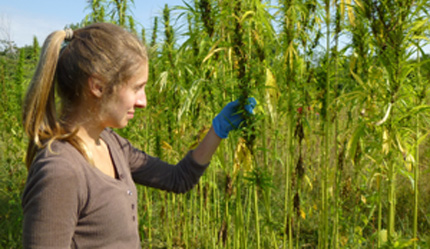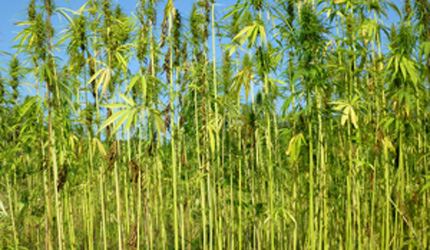5585 Guilford Road • Madison, WI 53711-5801 • 608-273-8080 • Fax 608-273-2021
www.agronomy.org
Twitter | Facebook
NEWS RELEASE
Contact: Hanna Jeske, Associate Director of Marketing and Brand Strategy, 608-268-3972, hjeske@sciencesocieties.org
Growing industrial hemp in eastern Canada: a new frontier
Oct. 19, 2016 - What if there was one crop that could produce a variety of really useful products? Growing this crop would probably seem like a no-brainer. Unless this crop is industrial hemp.
 Industrial hemp, one variety of the plant Cannabis sativa, can produce a wide variety of products. However, because hemp is a relative to marijuana, growing the crop is still illegal in many countries.
Industrial hemp, one variety of the plant Cannabis sativa, can produce a wide variety of products. However, because hemp is a relative to marijuana, growing the crop is still illegal in many countries.
In Canada, growing industrial hemp was legalized in 1998. Eighteen years later, producers still face many challenges. Farmers first have to get a license from the government to grow hemp. Then they can only plant the seeds of specific cultivars, or types, of hemp. These specific cultivars have been approved by the Canadian government because they contain minimal amounts of THC. (THC is the psychoactive component found in marijuana.) Finally, farmers in eastern Canada face an additional challenge because very little is known about how to grow hemp in eastern Canada.
Industrial hemp grows best in drier soil conditions, like those in western Canada. Farmers know which cultivars grow best in the west. But they don’t know which of the 45 approved cultivars are best suited for growing in the wetter conditions of the east. These farmers often have to rely on consulting with other local producers and trial and error.
Coming to the aid of eastern Canadian hemp producers is Philippe Seguin, associate professor at McGill University, Montreal, Quebec, Canada. Seguin wants to help farmers in eastern Canada learn more about which hemp cultivars work best in their environment.
He and his team of researchers selected 11 cultivars and planted them in seven different environments in Quebec. Seguin kept detailed records of when the seeds were planted and how much fertilizer was used. The plants were then harvested, and the amounts of biomass and seeds produced were measured. Biomass is the plant material that is used for making textiles, insulating materials, and other fiber products. The hemp seeds are used for food products and as a source of oil.
 The researchers discovered the amounts of biomass and seeds the cultivars produced varied in the different environments. They also found the cultivars performed differently in eastern Canada than they do in western Canada. Some cultivars performed consistently across the environments in Quebec. It means some of the cultivars can adapt to conditions in the east. “This finding is promising for local producers,” Seguin notes.
The researchers discovered the amounts of biomass and seeds the cultivars produced varied in the different environments. They also found the cultivars performed differently in eastern Canada than they do in western Canada. Some cultivars performed consistently across the environments in Quebec. It means some of the cultivars can adapt to conditions in the east. “This finding is promising for local producers,” Seguin notes.
The cultivars that appear to be best suited for growing in eastern Canada include Ferimon, Anka, and Jutta. Seguin found that these cultivars consistently produced high yields of both biomass and seeds. These cultivars have the potential to produce moderate amounts of biomass compared to western Canada. He also found that these cultivars may have the potential to produce high amounts of seeds compared to western Canada.
Even with these discoveries, there is still plenty to learn about growing hemp in eastern Canada. Research can now look at specific recommendations for growing hemp in eastern Canada: the best times to plant the seeds, how much fertilizer to use, and the best times to harvest. And there are still other environments within eastern Canada to explore. Cultivars specifically for the environments of eastern Canada are needed.
Overall, Seguin is optimistic. “Unlike many ‘new’ crops, industrial hemp has demonstrated its potential in the past; it only remains to be ‘rediscovered.’”
With the help of Seguin and his team, farmers will be able to rediscover industrial hemp in this new frontier of eastern Canada.
Read more about Seguin’s research in Agronomy Journal.
Agronomy Journal is the flagship journal of the American Society of Agronomy. Articles convey original research in agriculture, natural resources, soil science, crop science, agroclimatology, agronomic modeling, production agriculture, and instrumentation.